Revision Notes: Elementary Theory of Demand | Economics for SSS 1 PDF Download
Concept of Demand
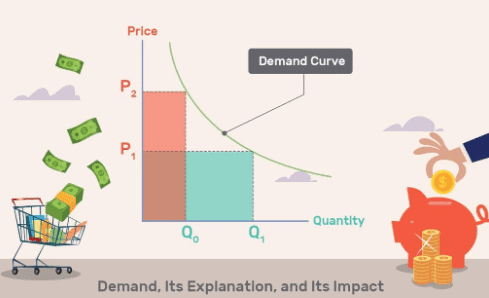
- Demand for a good involves three key elements: desire to buy the good, purchasing power to afford it, and willingness to spend the money.
Individual Demand vs. Market Demand
- Individual Demand refers to the quantity of a product that a single household is ready to buy at a specific price within a certain time frame.
- Market Demand is the total of individual demands in the market, showing the different quantities of a product that all consumers are willing to purchase at various prices during a specific period.
Factors Influencing Individual Demand
- Price of the Commodity: When the price of a commodity increases, the purchasing power of the consumer decreases, leading to a reduction in the quantity purchased. Conversely, a price decrease enhances purchasing power and demand.
- Income of the Consumer: An increase in individual income, with other factors constant, boosts the consumer's purchasing power, allowing for the purchase of more commodities.
- Price of Related Goods: Demand for a commodity is influenced by its own price and the prices of related goods, which can be substitutes or complements. A change in the price of one good affects the demand for another.
- Tastes and Preferences: A shift in individual tastes and preferences impacts the demand for a commodity, as consumers are more likely to purchase goods that align with their current preferences.
Factors Influencing Market Demand
- Pattern of Income Distribution: The distribution of income within a population affects market demand. If income distribution favors lower-income individuals, demand for basic commodities increases. Conversely, if income is concentrated among the wealthy, demand for luxury goods rises.
- Climatic Conditions: Seasonal changes influence market demand for certain commodities. For example, demand for woollen clothes rises in winter, while demand for cotton clothes increases in summer.
Types of Demand
- Income Demand
- Cross Demand
- Joint Demand
- Composite Demand
- Competitive Demand
- Direct Demand
- Derived Demand
- Planned Demand
Law of Demand
The Law of Demand indicates that, all else being equal, when the price of a good decreases, the quantity demanded increases, and when the price increases, the quantity demanded decreases.
Key Assumptions of the Law of Demand
- The prices of related goods remain unchanged.
- Consumers' incomes are constant.
- Consumers' tastes and preferences do not change.
- There is no expectation of a future change in the price of the commodity.
Demand Schedule vs. Market Demand Schedule
- Demand Schedule: A demand schedule is a table that displays the quantities of a commodity that consumers are willing to purchase at various prices.
- Market Demand Schedule: This shows the total demand for a commodity in the market at different price levels.
Individual Demand Curve and Market Demand Curve
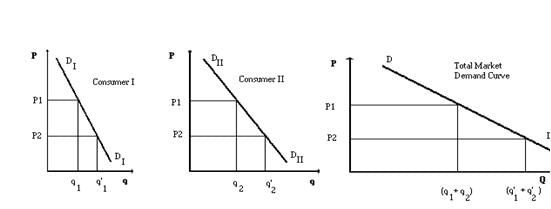
Individual Demand Curve
- The individual demand curve illustrates the different quantities of a commodity that a specific buyer is willing to purchase at various prices at a given time.
- In this curve, the quantity of the commodity is plotted on the x-axis, while the price is shown on the y-axis.
- The downward-sloping curve, represented as DD, indicates an inverse relationship between price and quantity demanded, meaning that as price decreases, the quantity demanded increases.
Market Demand Curve
- The market demand curve is obtained by horizontally summing the individual demand curves of all consumers in the market.
- It shows the various quantities of a commodity that all consumers in the market are willing to buy at different prices at a specific time.
- The market demand curve also slopes downward, reflecting the inverse relationship between price and quantity demanded, similar to the individual demand curve.
Reasons for the Downward Slope of the Demand Curve
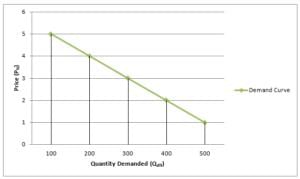
The demand curve slopes downward to the right because there is an inverse relationship between the price of a good and the quantity demanded. When the price of a good falls, more of it is purchased. Several factors contribute to this downward-sloping demand curve:
- Law of Diminishing Marginal Utility: The marginal utility refers to the additional satisfaction a consumer derives from consuming one more unit of a commodity. According to the law of diminishing marginal utility, as a consumer consumes more of a commodity, the additional satisfaction derived from each extra unit decreases. A consumer achieves maximum satisfaction when the price paid for a commodity equals its marginal utility. If the price is higher than the marginal utility, the consumer will reduce consumption.
- Substitution Effect: The substitution effect occurs when a consumer replaces one commodity with another when the price of the former increases relative to the latter. For example, if the price of apples rises, consumers may buy more oranges instead.
- Income Effect: The income effect refers to the change in quantity demanded resulting from a change in the real income of the buyer due to a change in the price of a commodity. When the price of a good falls, the real income of the consumer effectively increases, leading to an increase in quantity demanded.
Exceptions to the Law of Demand
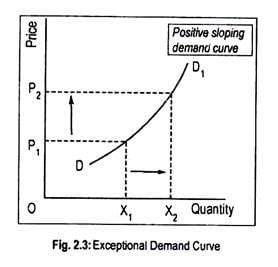
1. Giffen Effect: The Giffen effect is observed in certain inferior goods consumed by low-income individuals. When the price of such a commodity rises, poor people may reduce their purchases of more expensive items and increase their consumption of this commodity. For example, if the price of bread rises, low-income individuals may buy more bread and less of other more expensive foods.
2. Bandwagon Effect: The bandwagon effect occurs when a consumer’s demand for a commodity is influenced by the preferences and tastes of the social class to which the consumer belongs. For instance, if a particular brand of clothing becomes popular within a social group, individuals within that group may increase their demand for that brand, regardless of their personal preferences.
Changes in Demand
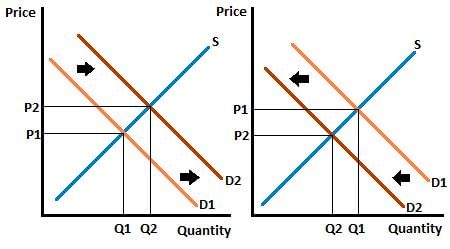
Demand for any commodity depends on several factors besides its price. These factors were categorised as price of the commodity in category 1 and all factors other than price in category 2. Based on these categories of factors influencing demand, changes in demand are divided into
Change in Quantity Demanded and Change in Demand
- Change in quantity demanded is the movements along the demand curve, i.e. the extension of demand caused by a decrease in the price of the same good and the contraction of demand caused by an increase in the price of the same good.
- Change in demand means the shifts in the demand curve, i.e. the decrease in demand or the backward shift in the demand curve caused by a change in factors other than the price of the good and an increase in demand or a forward shift in the demand curve caused by a change in factors other than the price of the good.
Causes behind Shifts of Demand
- Change in Income: If there is an increase in income of consumers, they will usually buy more of any particular commodity and the demand curve will shift to the right. A fall in income will usually shift the curve to the left. This is applicable to most goods which are normal goods.
- Price of other commodities: If the price of substitute goods falls, consumers will be attracted to the other goods and the demand for the good to consume will fall at any given price. Hence, the demand curve will shift to the left. Likewise, a rise in the price of a substitute will shift the demand curve to the right. If the price of the complementary goods falls, consumers will buy more of the complementary goods and the demand for the good to consume will also rise at any given price. Hence, the demand curve will shift to the right. Similarly, a rise in the price of complementary goods will shift the demand curve to the left.
- Consumer preference: If the producers spend more money on a product advertisement at any given price, consumers will demand the commodity in greater quantities than before. Hence, the demand curve for the commodity will shift to the right. Likewise, if consumers develop distaste for a commodity, the demand curve will shift to the left.
|
46 docs|8 tests
|
FAQs on Revision Notes: Elementary Theory of Demand - Economics for SSS 1
| 1. What is the Law of Demand and how does it explain consumer behavior? |  |
| 2. What are individual demand curves and how do they differ from market demand curves? |  |
| 3. Why does the demand curve typically slope downwards? |  |
| 4. What are some exceptions to the Law of Demand? |  |
| 5. What is the difference between a change in quantity demanded and a change in demand? |  |
















